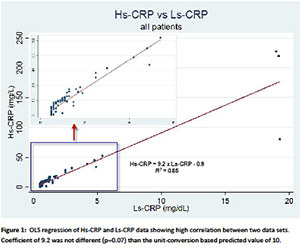A Simple Conversion between High and Low Sensitivity CRP in the Assessment of PJI
Authors: Milone MT, Kamath AF, Israelite CL University of Pennsylvania, Philadelphia, PA
Title: A Simple Conversion between High and Low Sensitivity CRP in the Assessment of PJI
Background: With the emergence of high-sensitivity CRP (Hs-CRP) as a marker of cardiovascular inflammation, hospitals are transitioning away from low-sensitivity CRP (Ls-CRP). Although modern Hs-CRP tests have been proposed to be a more accurate than Ls-CRP with a wider dynamic range, and Ls-CRP has been shown to be an important tool for the evaluation of peri-prosthetic infection (PJI), no orthopaedic studies have evaluated a correlation between Ls-CRP and Hs-CRP nor Hs-CRP’s ability to diagnose septic arthroplasty.
Hypothesis/Purpose: To (1) characterize serum Hs-CRP values in patients with suspected PJI (2) evaluate the correlation between Hs-CRP and Ls-CRP as well as ESR (3) and generate and compare the infection diagnosing sensitivity, specificity, and ROC curves of these markers.
Methods: We retrospectively reviewed the serum laboratory data of 83 non-consecutive TKA or THA patients with serum Hs-CRP, Ls-CRP, and ESR values obtained on the same day as either pre-operative revision labs or in the work up for suspected PJI. The diagnosis of infection was made by growth of aspirated or surgical tissue cultures. We used paired t-tests, OLS regressions, and ROC curves to analyze the data.
Results: Mean Hs-CRP was 7.2 mg/L in uninfected patients and 77 mg/L in the infected group (p<0.01). Hs-CRP was highly correlated (R=0.92) with Ls-CRP and regression analysis revealed a conversion factor of 9.2 (p<0.01) that was no different (p=0.07) from unit conversion. ROC curves showed 100% sensitivity and 99% specificity for both Hs-CRP and Ls-CRP with respective cut offs of 28.5 mg/L and 2.5 g/dL.
Discussion: Hs-CRP was highly correlated with Ls-CRP, and statistical analysis revealed no difference when the tests were conformed to the same units. Because Hs-CRP is typically reported in mg/L and Ls-CRP in mg/dL, this results in a multiple of 10 difference. This suggests that Hs-CRP tests may be equivalent to Ls-CRP at higher orthopaedic ranges despite their superiority at lower cardiovascular levels. ROC curve analysis revealed nearly identically high sensitivity, specificity, and accuracy of Hs-CRP and Ls-CRP.
Conclusion: In the setting of PJI, serum Hs-CRP increases in proportion to Ls-CRP. Hs-CRP and Ls-CRP are highly correlated and unit reconciliation may be employed to convert between the two tests. Both Hs-CRP and Ls-CRP are sensitive and specific tests for the evaluation of PJI.

